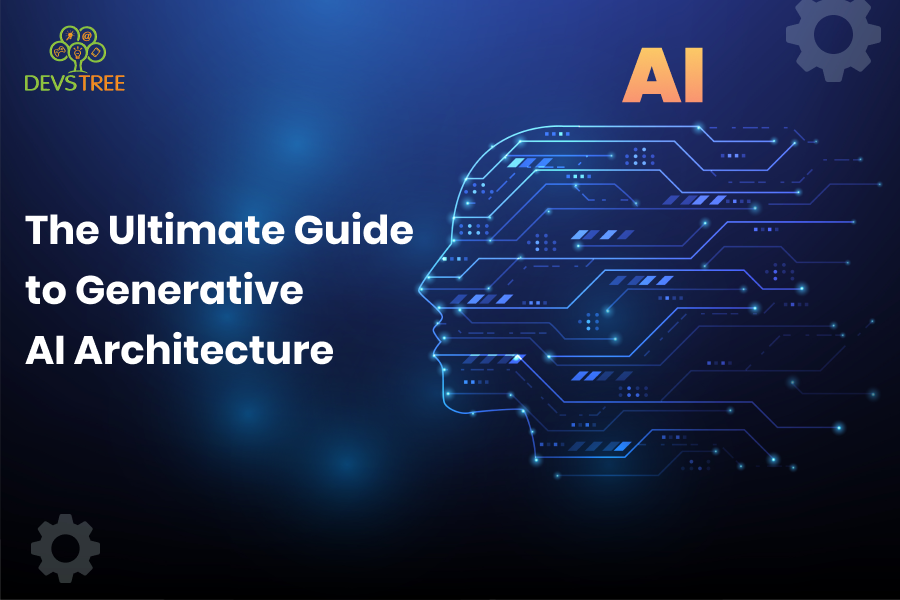Generative AI is an innovation cornerstone with abilities that have never been unlocked for content, data analysis, and so much more. So, it forms an integrated yet complex architecture that builds core pieces, models, and applications so, this guide is imperative in understanding just how the technology works and how it can be used by an artificial intelligence development company to the respective industries.
What is Generative AI?
Most of these are referred to as generative AI; they are systems that can create new data similar to existing datasets. Unlike conventional AI, generative AI focuses on the output of new things mostly rather than predicting or classifying. Their applications are vast and diverse from arts and design to sectors like real estate finance and sports.
Principal Components of Generative AI Architecture
1. Data Preprocessing:
Data pre-processing is an essential requirement in the performance of generative models. This type of pre-processing transforms the raw data into a structural format, which enhances model correctness and efficiency.
- Quality of Data: Exquisitely good-quality diverse datasets can lead to better performance in the model involved.
- Data Cleaning Techniques: These techniques include filtering and normalization that prepare the data fed into the model for training purposes, ensuring that no biases have a place among the data.
2. Model Selection:
The choice of the model is essential to achieve better performance. Each generative model has its strengths and applications.
- Popular Generative Models: The most key ones are GANs, VAEs, and transformers, each best suited for a specific application.
- Comparison Based on the Application: Different models will prove more suited for different applications—be it image generation or text synthesis.
Deep Dive into Generative AI Models
Generative Adversarial Networks (GANs):
GANs consist of two neural networks: a generator that generates data, and a discriminator that criticizes it. Adversarial training only heightens the quality of output at the generator.
- Composition: The game between the generator and the discriminator is critical.
- Applications: GANs have found extensive utilization in the generation of images artworks and so forth.
Variational Autoencoders:
VAEs learn to encode input data into a compressed representation, and then decode it to generate new samples. They generally effectively balance the trade-off between reconstruction accuracy and regularization.
- Structure: Composing an encoder, decoder, and latent space, VAEs make them optimum for compressing data and anomaly detection.
- Use Cases: The VAE can be used for sample creation with diverse samples across different domains.
Transformers:
Transformers use self-attention mechanisms to handle sequential data effectively. Current leading models include GPT-3 and BERT, which are exceptional in natural language processing.
- Architecture: Their encoder-decoder architecture enables them to manipulate the most complex data.
- Applications: Text generation, translation, and context understanding are basic applications for the transformers.
Layers of Generative AI Architecture
1. Data Processing and Ingestion
This layer will collect raw data from several sources and process it ready for training. Then the application goes about the proper preprocessing eliminating biases and ensuring quality.
2. Core Generative Model
The basic generative model produces data samples based on some patterns it might have discovered in the training data. The correct choice of model is what will make it succeed- GAN, VAE, or maybe a transformer.
3. Optimization and Feedback Loop
This layer optimizes the model performance within itself with feedback so that it improves accuracy and the quality of output over time.
4. Deployment and Integration
Deployment throws generative models into real-world situations, allowing them to interact with APIs and set up infrastructure.
5. Application and Use Cases
It presents flexibility in application fields such as art, design, and data augmentation.
6. Data Management and API Handling
Does good data management and API handling enable one to easily retrieve and interact with generative models?
7. Prompt Engineering and LLM Operations
Describes the designing of effective prompts for big language models or LLMs, as well as managing their training and deployment.
8. Model Repository and Accessibility
Centralized repository of generative models: This allows for ease of access and control of different versions of applicability.
9. Infrastructure Scalability
The processing requirements of generative models are taken care of, making this layer secure to prevent all types of extreme training and deployment.
Trends and Developments
This advancement will continue to chase better algorithms, more computing power, and better models of data. It may even see the integration of generative AI into the world of quantum computing and blockchain in the future.
Conclusion:
And so, with any advanced technology, there are a few more challenges to be faced and ethical concerns that need to be addressed. With responsible practices and staying on top of what’s currently available, organizations will unlock the transformative impact of generative AI to make real progress.
We, at Devstree an AI development company in India, offer the best all-around Artificial Intelligence Development Services through generative AI model generation and maintenance. Hire AI app developers now.

